It wasn’t long ago that Nissan/Infiniti revealed the VR30DDTT, and our article on that engine detailed a lot of the design choices that went into it and made it unique (fun fact, it also became our most popular article on this blog, by a huge margin).
Soon after, the cars they were destined for were announced (the 2016+ Q50 Sedan, and the 2017+ Q60 Coupe). The Q60 was especially exciting, being the replacement to the venerable G37 Coupe. Being that the G37 saw a handful of special editions, including the don’t-call-it-a-Nismo IPL Edition, we were excited to see what Infiniti would offer with the top of the line “Red Sport 400” variant of the Q60.
Sadly, Infiniti decided not to offer a manual variant of the Q60 at all. But we still knew this car, or at least this engine, would be Nissan’s performance platform going forward. We’re still hopeful we’ll see a future Z-car with the VR30DDTT engine, despite Nissan’s current financial and management issues.
So we bought one, brand new. Just a few days before SEMA 2017, we picked up a brand new 2017 Infiniti Q60 Red Sport 400. It’s RWD, silver paint and red interior. We immediately got to work learning as much as we could about the car.

The car spent the next few months getting various upgrades. We installed a Stillen splitter, Techanfit Brake lines, and HKS borrowed our car a few times to develop the incredible Hipermax coilovers and Hi-Power exhaust system for the Q60. We’ve documented a lot of these mods on our YouTube channel, so be sure to check that out if you’re interested.
Convenient Circumstances
The following May, Coz was out of town, and a few of us at the shop were talking about keeping the momentum going on some of our projects. Of course the thought of a manual swap had crossed our minds, but it was a pipedream. But with the cat away, the mice do play. And we already had the exhaust out and driveshaft out to help Inland Empire develop a 1pc aluminum driveshaft for the car. One thing lead to another and…
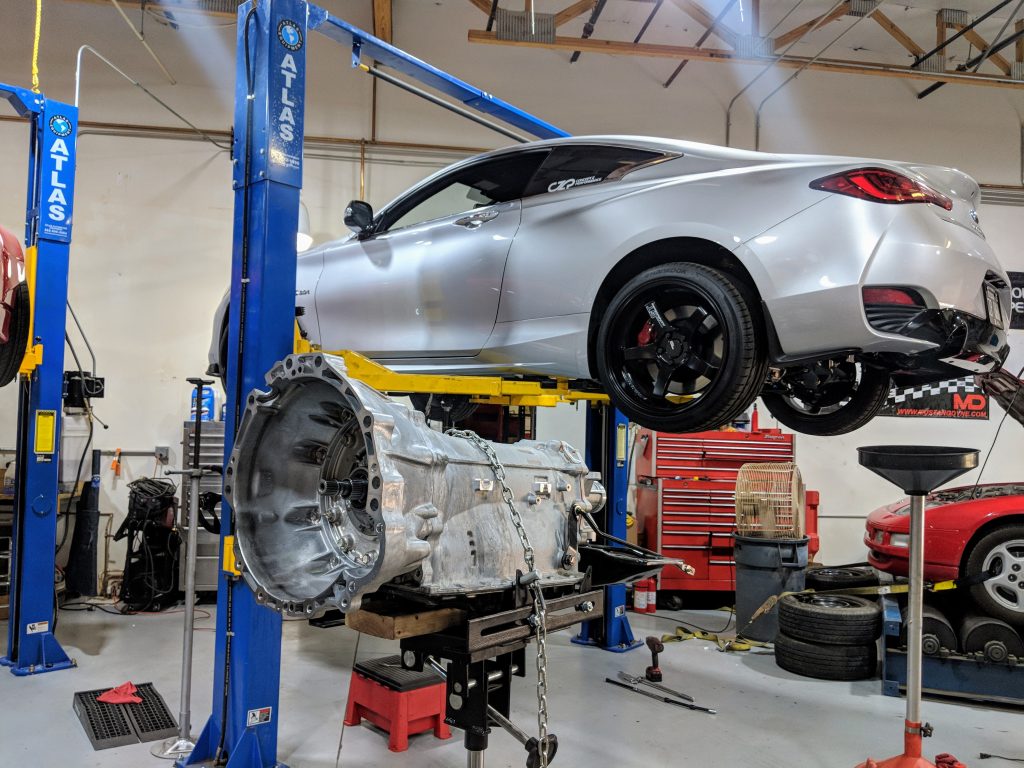
We took a few measurements and made some cardboard mockups and had pretty comfortably determined that bellhousing bolt pattern was fairly close to that of the 370Z’s Manual Transmission, so we decided to yank down the factory auto 7-speed trans and see for sure.
Once we got the transmission down, we pulled off the torque converter and flex plate, and found that the end of the crankshaft has a large pilot bushing adapter pressed in, just like the automatic 300ZX (of which this car is practically a direct predecessor) and various other Nissans. Key being, these are removable for use with a flywheel.
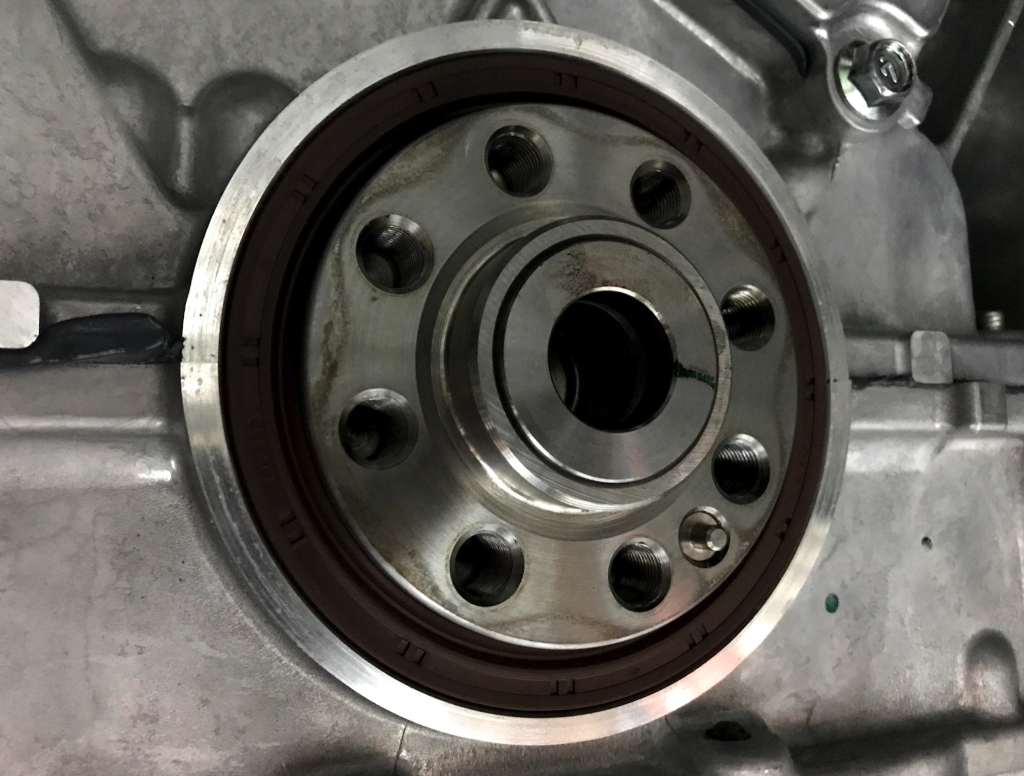
We also did a few more measurements and comparisons, and at this point realized we had a few immediate challenges to tackle, if we wanted to move forward with this project:
- There was a chance that the 370Z transmission still wouldn’t be a close enough fit. And even if it was, we don’t know if the spacing/height of the clutch/flywheel stack would be correct.
- The flex plate has a disc of fingers used to trigger the crank angle sensor. The pattern it uses was clearly unique to the VR30, meaning we couldn’t use an off-the-shelf flywheel.
- The crank position sensor was in a different location on the VR30, compared to where it would be on a VQ37 (meaning the bellhousings are machined differently).
- The area where a master cylinder would logically be placed was incredibly cramped and difficult to access; we weren’t sure if it would even be possible to fit a master cylinder there.
- We would have to figure out how to convince the world’s fussiest ECU to allow the car to start and drive, despite not having an expected TCM connected at all.
Cautious Optimism
So we got started. We happened to have a 370Z transmission new in stock, so we used that.
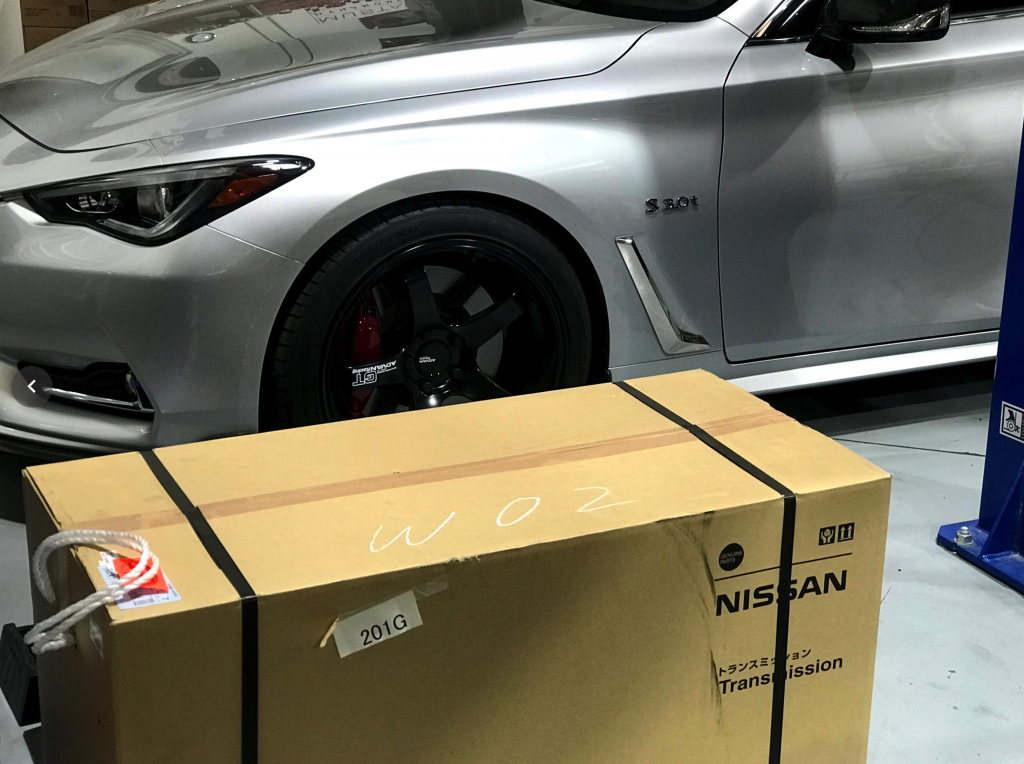
First, we test fit the transmission, and other than two bolts, everything lined up perfectly. CZP – 1, Nissan – 0.
Next, we test fit a 350Z flywheel. Surprise, the bolt pattern was the same! We took a donor Southbend Billet Steel flywheel off the shelf, removed the trigger disc, and Josh set about designing a new trigger disc that would mount up to this flywheel, but contain the correct pattern of teeth for the VR30 ECU. If you’re wondering why we didn’t start with a 370Z flywheel, it’s because the pattern was still wrong, and the trigger disc is the only difference between 350Z and 370Z flywheels.
Josh approximated the location of where the crank position sensor needed to be, and 3D printed a jig to guide where to drill and machine a relief in the bellhousing.
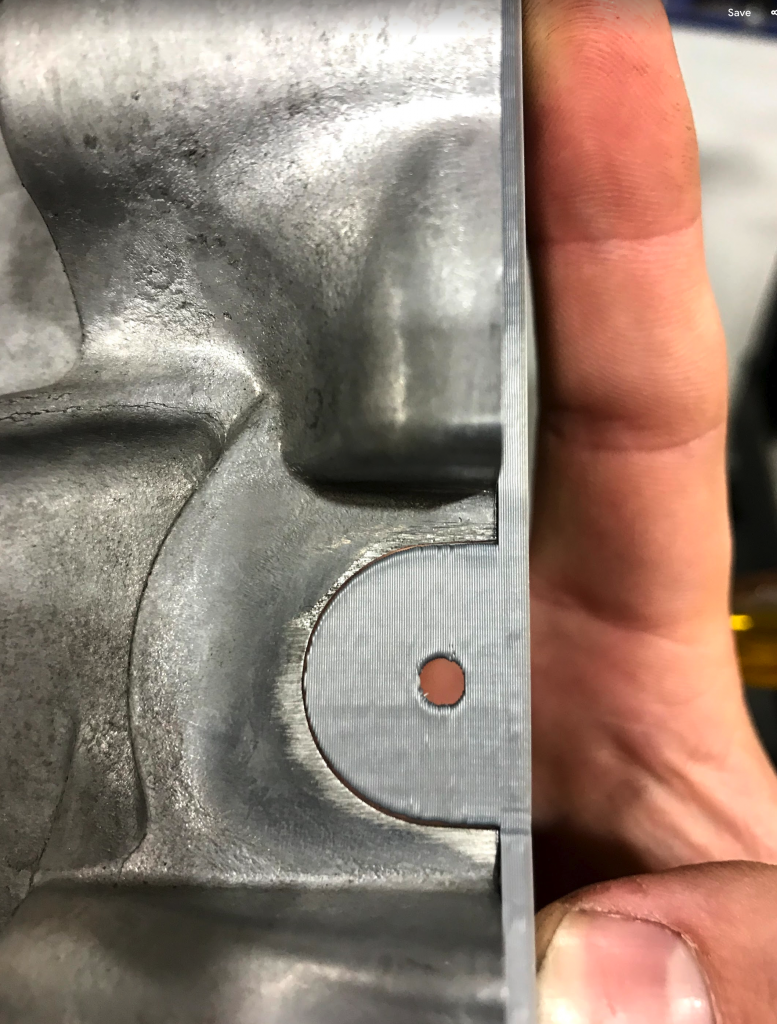
This also left the factory relief, for the sensor on the VQ37, open and exposed, so Josh also made a simple 3D printed plug to fill in the gap and keep out dust.

We got the flywheel, clutch, and transmission mounted up. Being brand new from Nissan, the transmission came with a concentric slave cylinder pre-installed, but at this point we had nothing to plumb it to. We also had no driveshaft, no shifter, no pedal, etc. But by this time, we had our custom trigger disc installed on the flywheel, and along with the transmission and starter installed, it allowed us to see if we could get over what is arguably the most important hurdle: getting it to start.
The First Major Hurdle
On the auto trans, the TCM is actually inside the transmission. Without the transmission, there would be nothing to talk to the rest of the car. Understandably, the car wouldn’t even crank. Luckily, I had access to the factory service manual for this car, and after a lot of wire tracing, I narrowed down a few pins on the TCM harness connector of interest. Most notably, a pin to activate the starter inhibitor relay, along with power, ground, and the signal for the reverse lights/camera. The rest of the pins are used for CANBUS communication between the TCM and the ECU and gauge cluster.
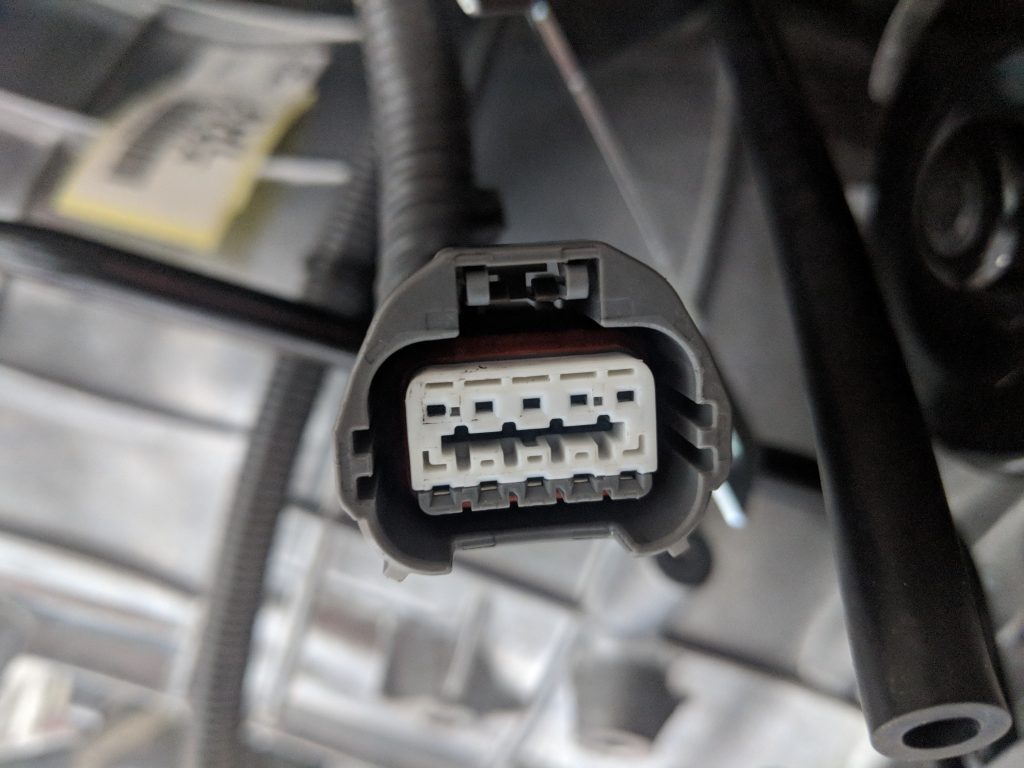
I rigged together a simple jumper to try connecting some of these pins, and eventually narrowed down the two pins needed to activate the starter inhibitor relay, as well as the pins needed to activate the reverse lights/camera.
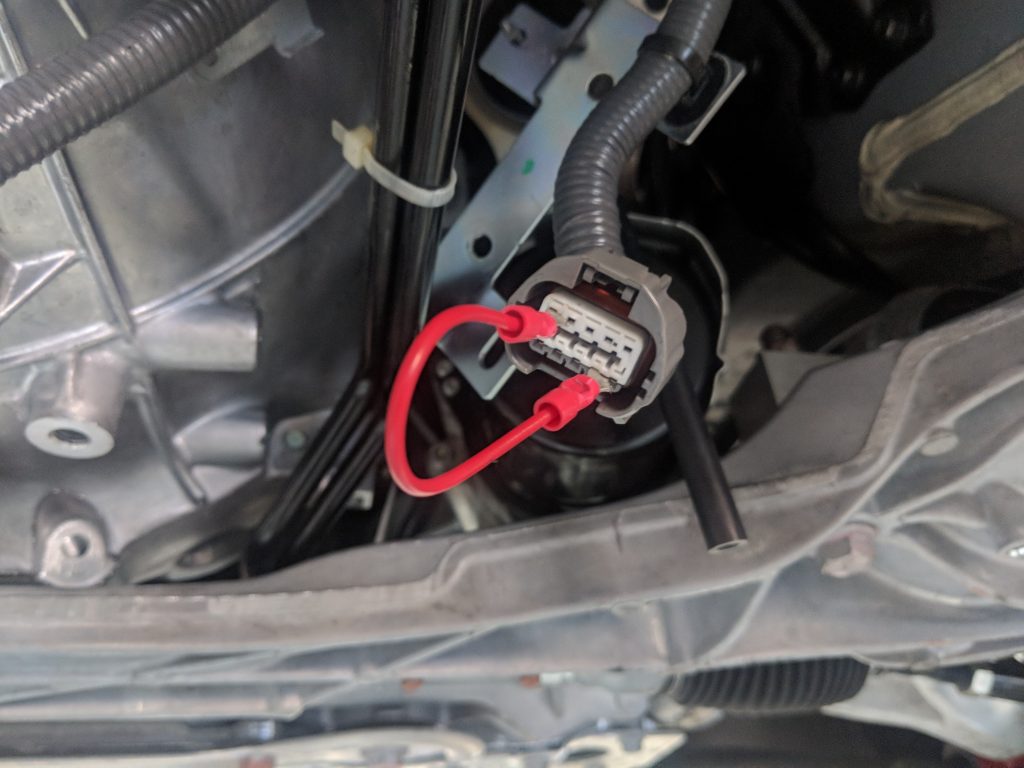
To our extreme relief, satisfying the starter inhibitor relay is all it took to make the car crank and start. The starter meshed perfectly with the flywheel and it fired right up, though we didn’t allow it to run because it only had upper downpipes installed, blowing hot exhaust gas all over the transmission area.
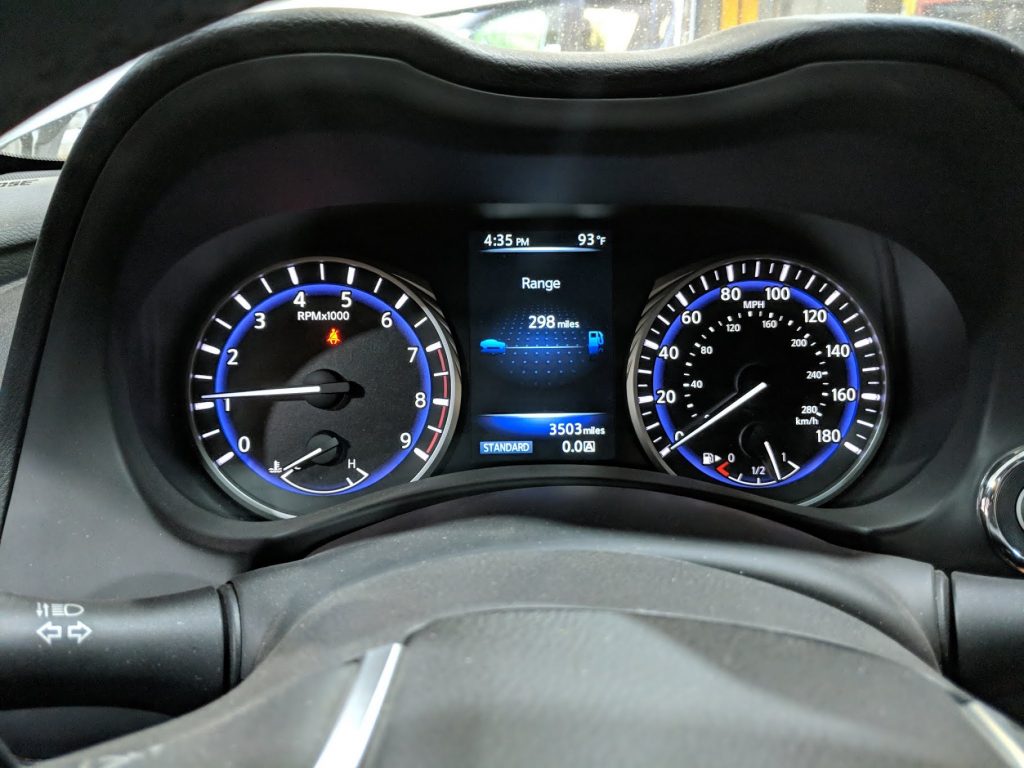
I was able to put together a simple harness that connected to the factory TCM connector and utilized the factory reverse and neutral switches on the 370Z transmission.
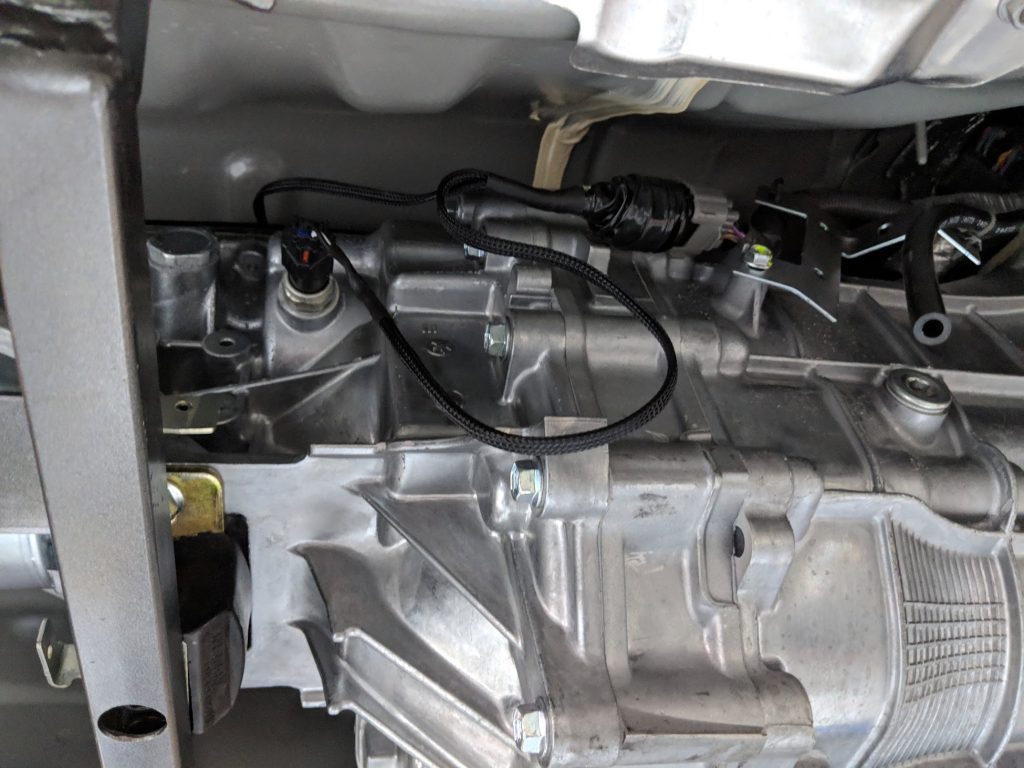
This was pretty quick and dirty, and I actually just used some solid core wire I had sitting around, which proved to be problematic as it eventually lead to some intermittent connection issues. The style of connector for the TCM is not a common style, so after a while, I made a new harness that used a more standard 6-pin connector (even though I only needed 4 pins). Instead of cutting and splicing, I depinned the factory connector, clipped and crimped new pins to the wires in question, and installed my new harness.
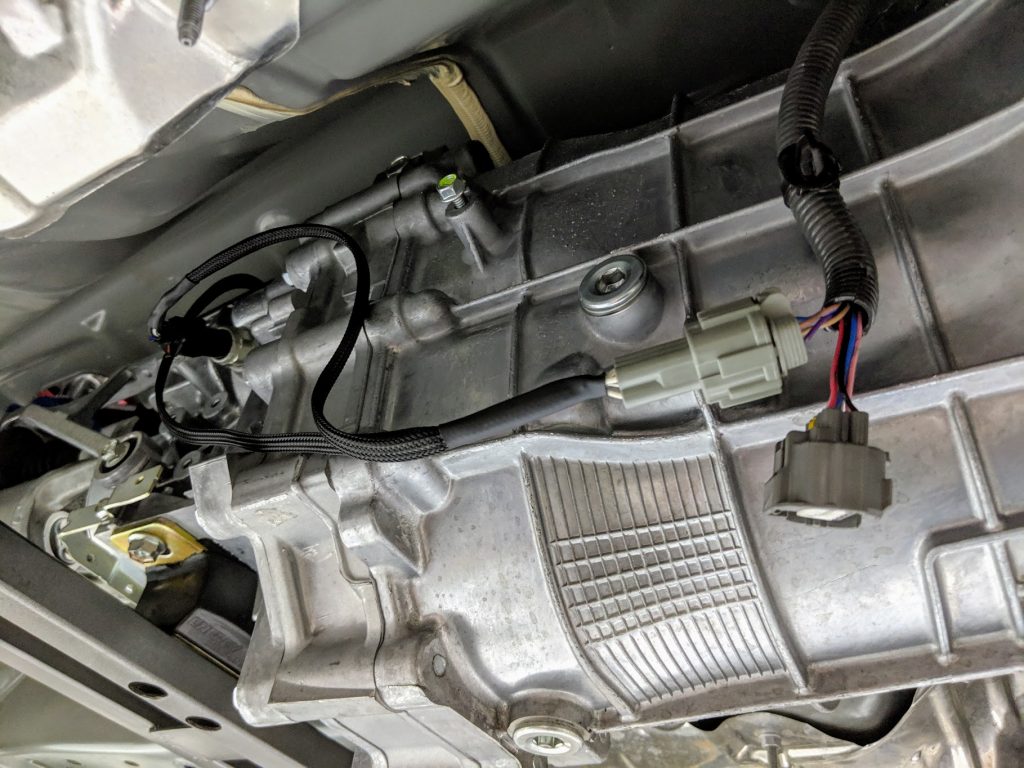
So, some custom wiring and a custom flywheel trigger disc is essentially all it took to actually make this thing start. Now, getting it to move under its own power would prove to be a little trickier.
The Point of No Return
Jumping forward a little bit, we had just had Inland Empire build a driveshaft for this car. The spline size/count at the transmission turned out to be the same on the manual, so we had them make a slightly longer version. Also up until this point, the transmission was resting on a piece of wood wedged in between itself and the factory trans mount crossmember. The mounting style was the same as the AT, but the position was just a little off. So Josh designed and welded up a custom transmission mount, which utilizes an off-the-shelf Energy Suspension urethane bushing (the same one used in the BDE 300ZX Trans Mount kit).
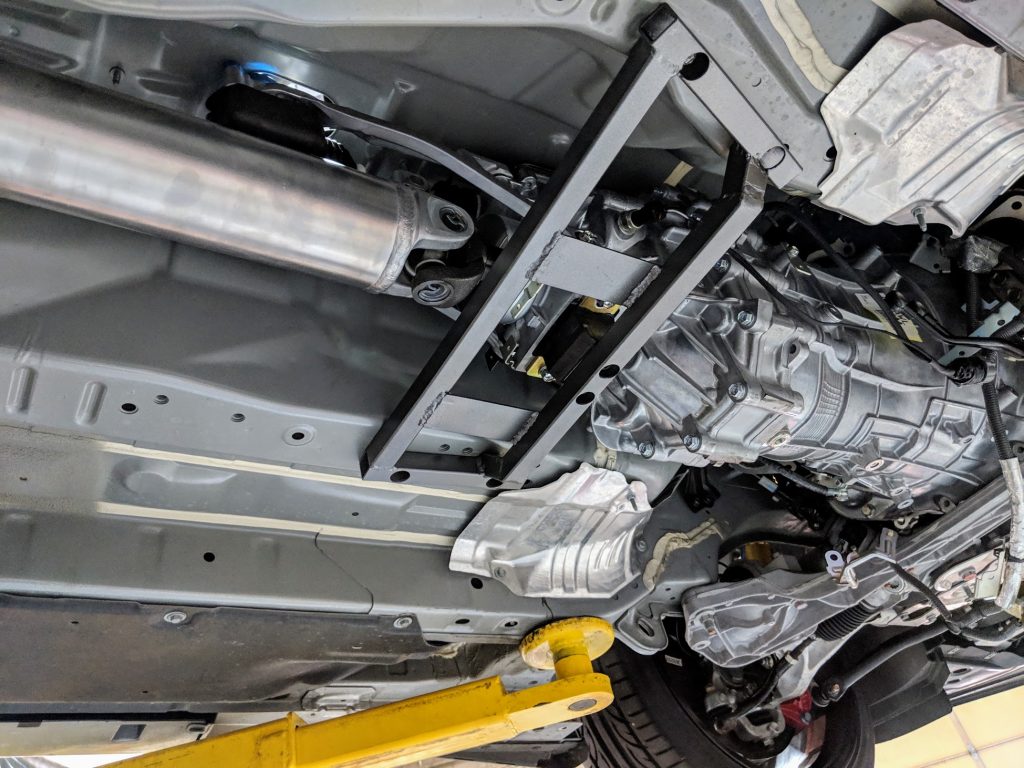
Josh had also opened up the shifter hole in the transmission tunnel a bit. The opening where the automatic shifter assembly passed through was just a little too far forward, so we just needed more clearance towards the rear.
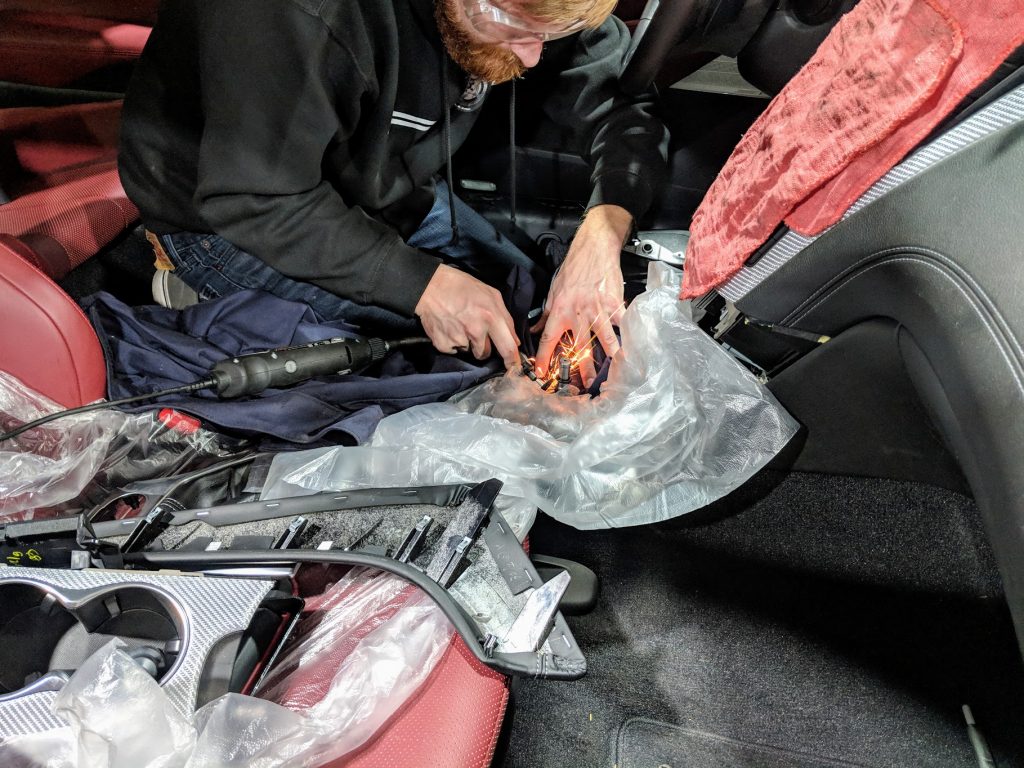
The next challenge here was to figure out how to get the clutch to disengage, which means we needed a pedal and a master cylinder. And the first step was figuring out how to mount it. Josh removed the factory E-brake (which is a foot brake) and brake pedal assemblies from the car to scope out the firewall area, until he discovered a very suspicious die-cut shape in the sound deadening.
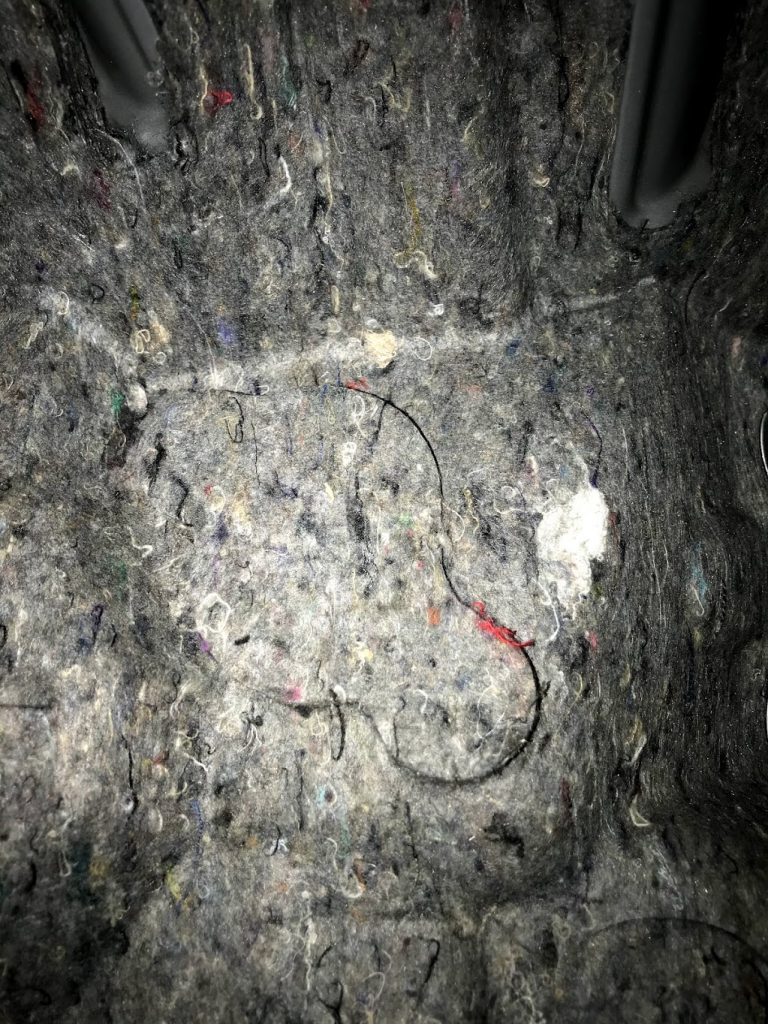
At this point, you may be wondering: “Nick, why is there a cutout in the sound-deadening material in the shape of a clutch master cylinder, on a car that only shipped as an automatic?” Well, we need to back up a little bit and talk about the car the Q60 was based on: the Q50. In Europe and South America, the Q50 Sedan has a 2.1L Base Model which is available with a manual transmission. The powertrain is completely unrelated and incompatible to anything we care about, but we’re starting to see more and more clues that Nissan did provision the chassis for a manual, as most of those components (including substantial parts of the chassis) were re-used for the Q60 Coupe.
Infact, it was shortly after this that I got to meet with one of the lead product designers for the Q60, who informed me that he and his team fought hard for a manual option, but the powers that be never let it happen. Clearly, they came close.
We decided to source the pedal assemblies from the Q50 Diesel Manual and see where they got us. Well, short version is it would require the clutch master cylinder from the Q50 as well. Due to space restrictions, the Q50 pedal places the master cylinder on the interior side of the firewall, and the hard hydraulic line passes through the firewall. Turns out, the hole for that tube exists on the Q60, it just has a rubber plug covering it.
But for the sake of utilizing parts that would be more easily accessible in the future, we decided to use a 370Z master cylinder and pedal, which were otherwise fairly close in mounting to the Q50 pedal assembly, and really didn’t demand much more space on the engine bay side.
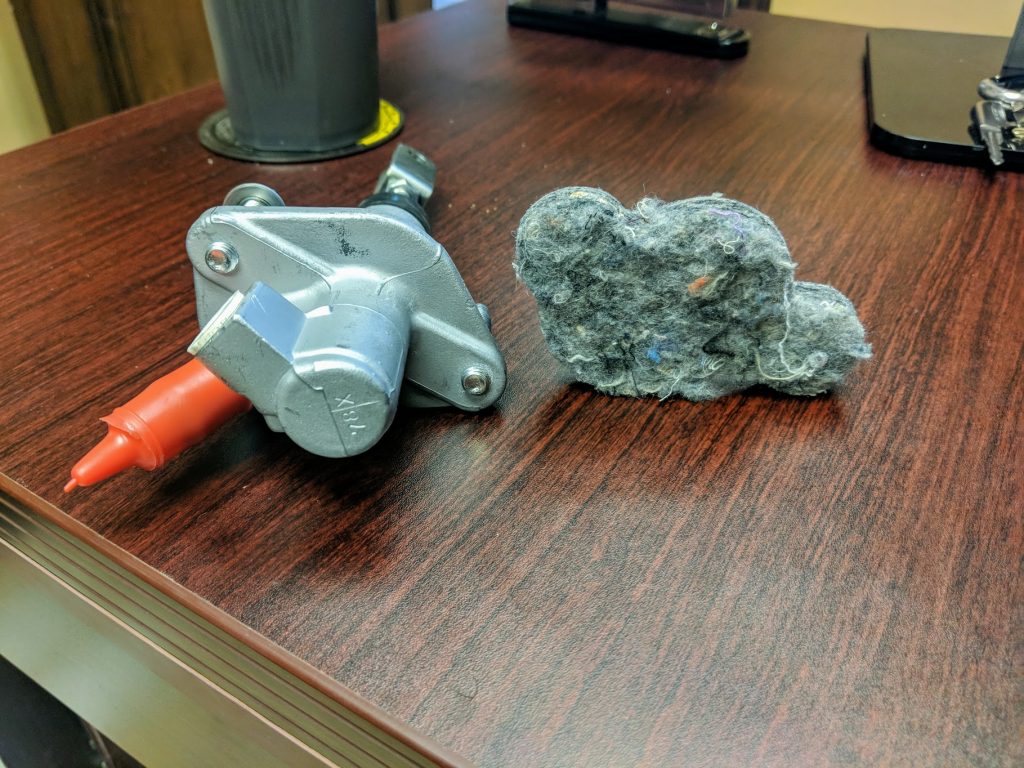
So we did some drilling and cutting, then some more drilling and some more cutting…
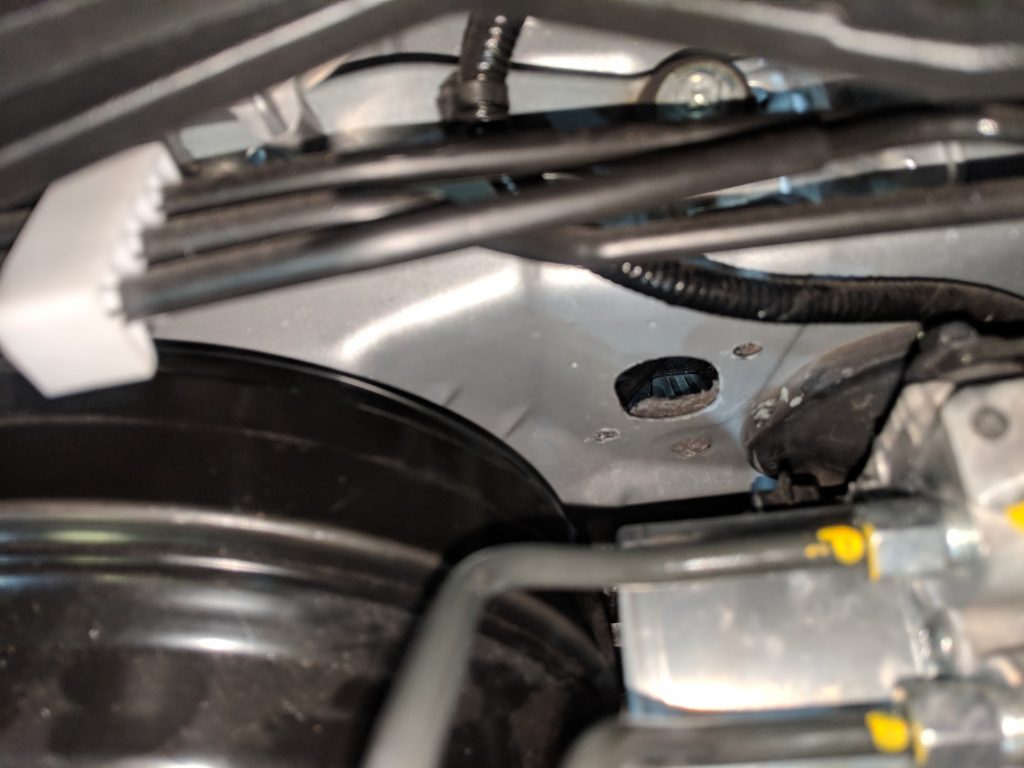
…And managed to get the master cylinder and pedal installed into the firewall.
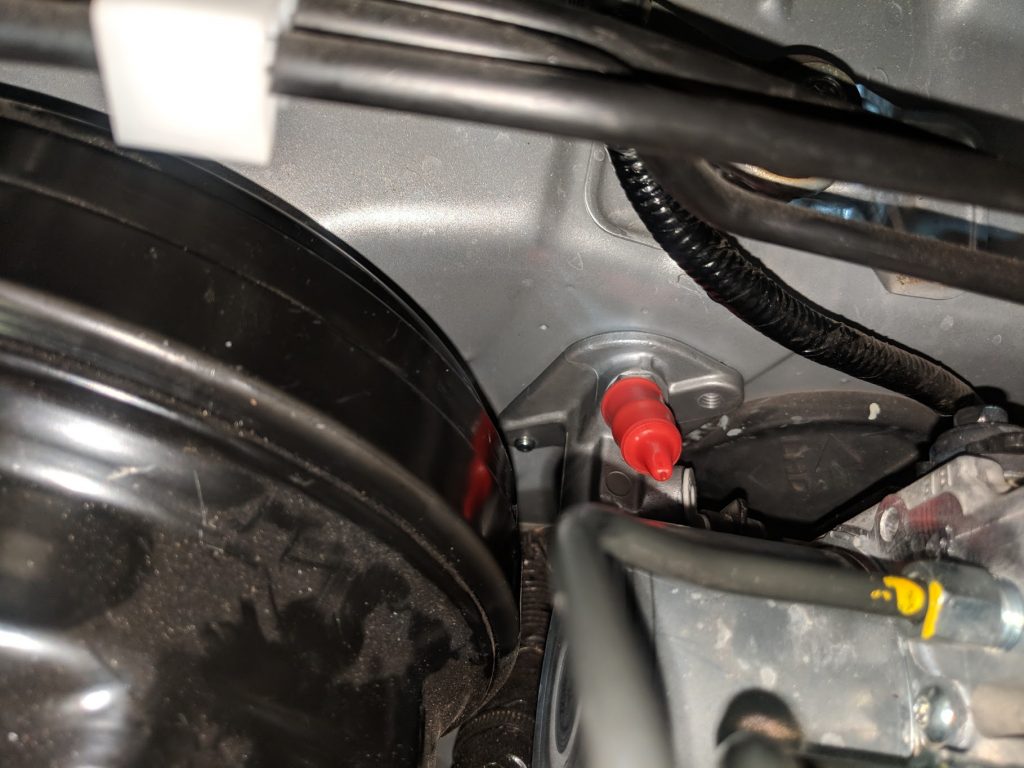
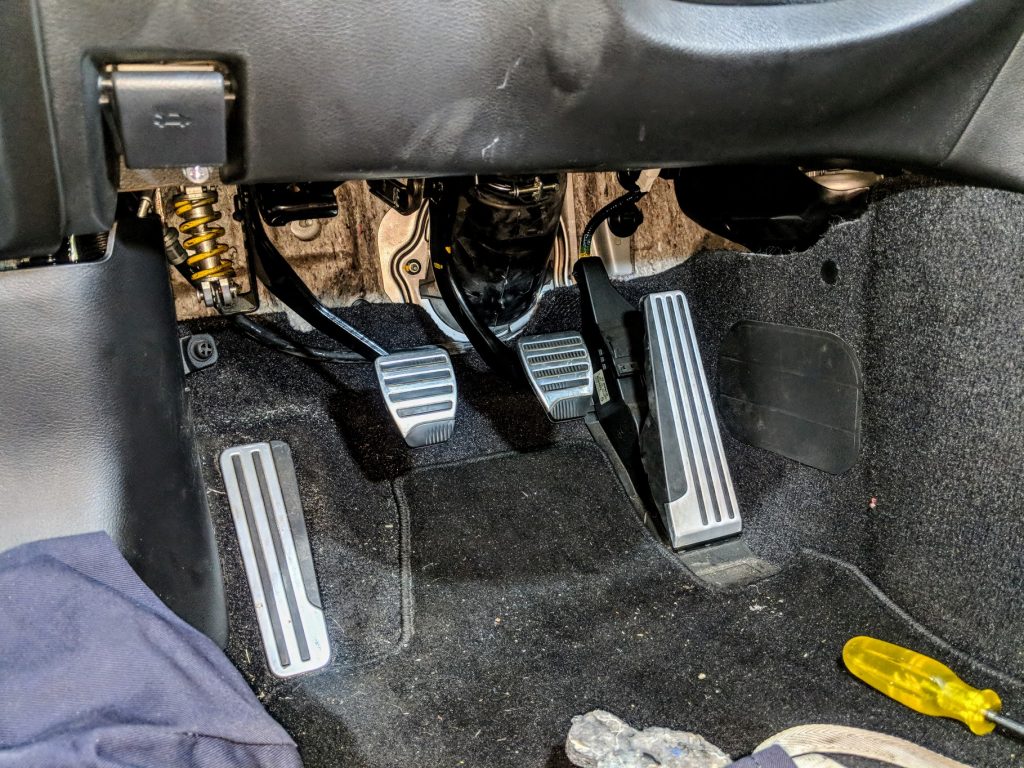
On the 300ZX, the auto and manual brake pedals are the same, except the auto has a wider pedal pad. You can cut it down and slip the rubber pedal cover on and it makes it identical to the manual. Guess what, it was exactly the same for the Q60. Pedals in!
Custom Parts
Around this time, Josh also designed and commissioned a custom clutch line from Technafit, so that was installed and routed to the slave cylinder.
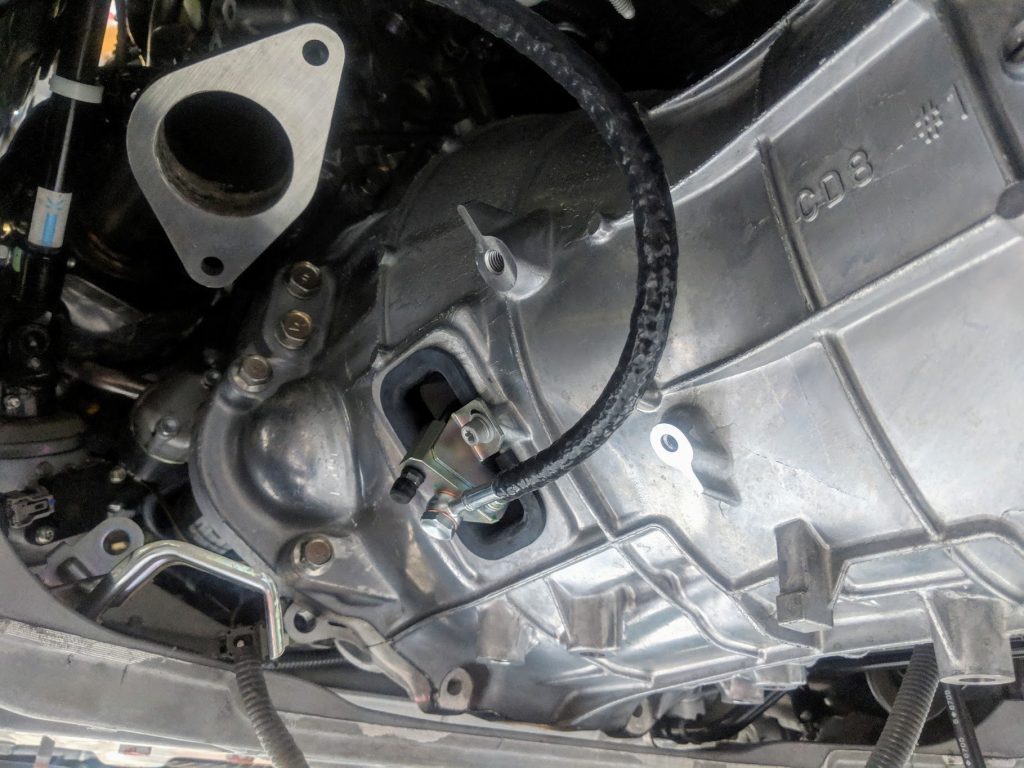
On the Euro Q50, it doesn’t have a dedicated clutch master fluid reservoir. Instead, the fluid is shared with the brake reservoir. In fact, if you take a look at your brake fluid reservoir on the US Q50 or Q60, you can actually see the dead spot where a hose port would have been.
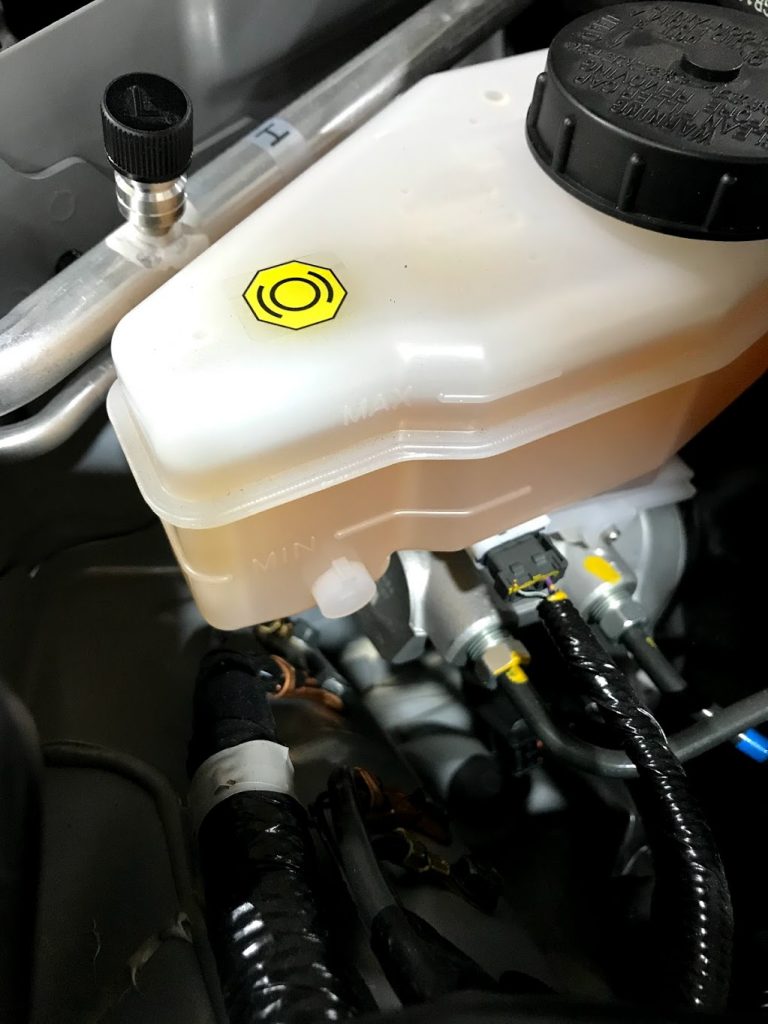
We decided to keep things a little more traditional, but still like-OEM, and gave it a dedicated reservoir. We utilized an OEM 350Z clutch fluid reservoir, and Josh designed a custom fluid reservoir hose to connect to the master cylinder, which we had manufactured specifically for this car.

Making Things Look Factory
Next, we need to talk about the elephant in the room here: the interior. While we had been messing with the pedal and hydraulic stuff, we were also considering how we would adapt the interior to allow for a manual shifter and, ideally, a handbrake (since the factory foot brake would interfere with the clutch pedal).
We initially thought about adapting the factory center console by removing the PRNDL indicator light and making a custom shift boot retainer, and that was somewhat promising at first.

But the opening is off-set to the left, and frankly it’s way too small. So we decided to try our luck at the next best option. We managed to track down the part numbers for the manual components from the Euro/Diesel model (which lack the silver carbon fiber flare of this car’s original parts, since they’re essentially coming from the base model) and ordered them. Ordering international parts through Nissan takes several months, so there was a lot of waiting around.
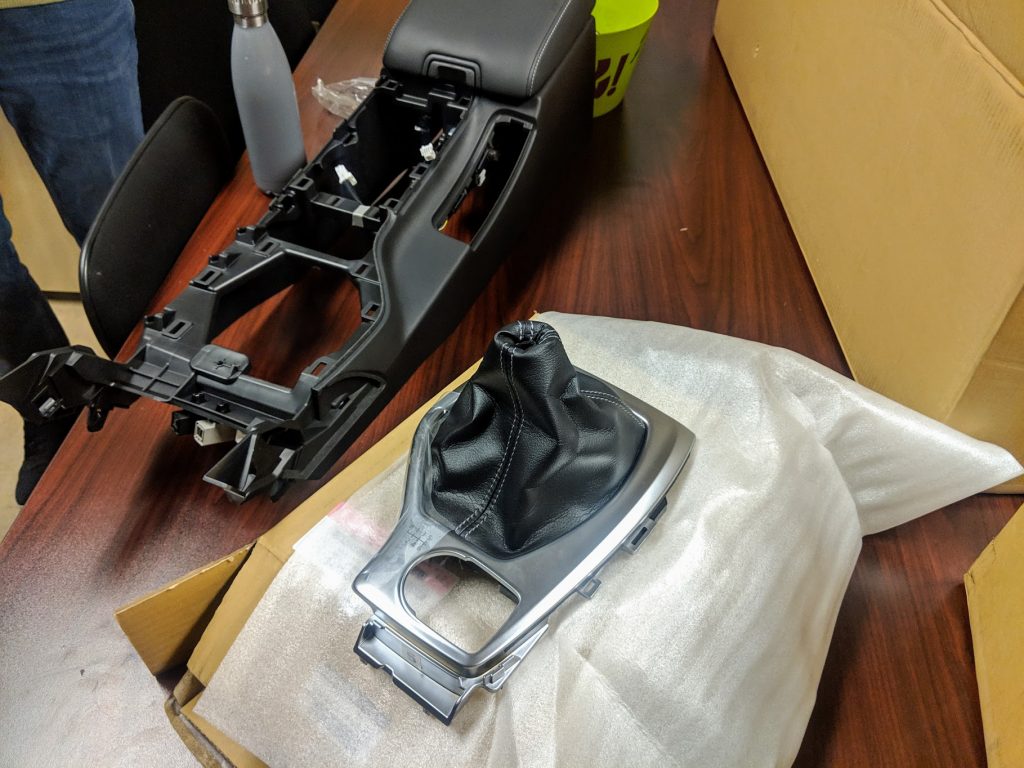
We started with just the center console and shifter finisher, before blowing a bunch of money on other components that potentially wouldn’t fit. But you can probably guess where this is going….
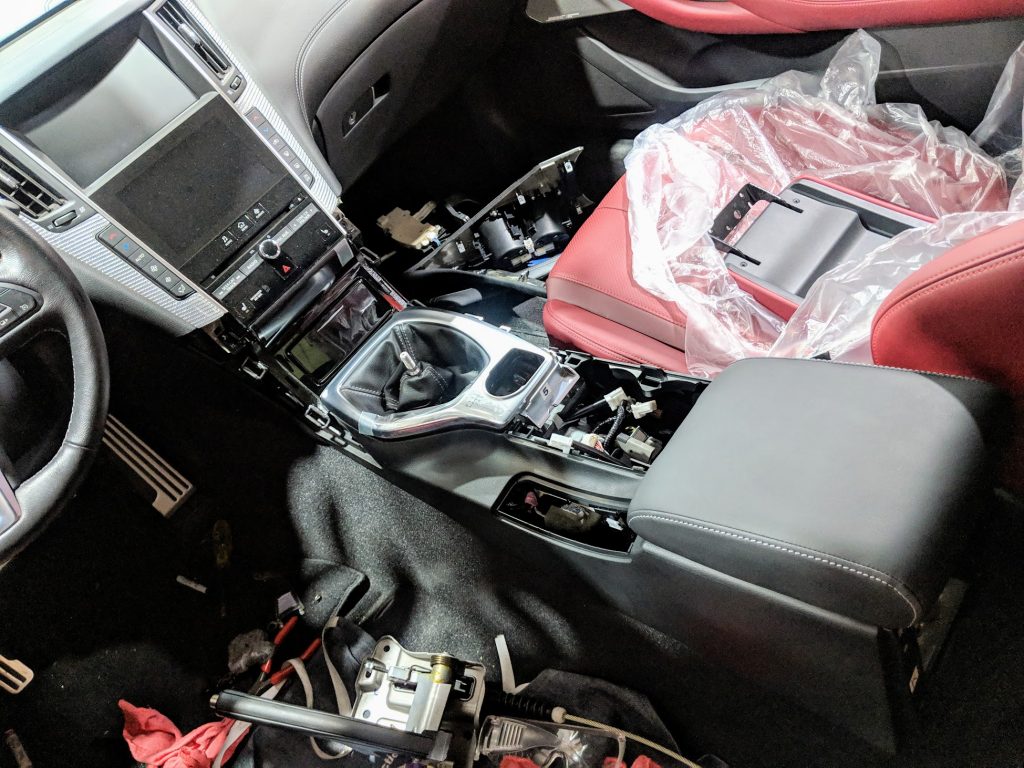
Proving the Concept
With the hydraulic stuff sorted, along with some promising progress on the interior side, we were ready to see if the car could move under its own power.
Needless to say, we were pretty stoked. It was far from done, but it worked.

Well, it mostly worked. The dash was lit up like a Christmas tree, it wouldn’t rev very high, and it was very sluggish about revving at all, practically building no boost. The ECU was in limp mode and it was clearly NOT happy about not being able to see the TCM.
So I ran codes, and disabled basically every code I could. Some of them were obvious (like Transmission Speed Sensor and CANBUS Communication Failure), but it didn’t help. I datalogged, and reviewed the logs, but all I could see was that the car was limiting throttle output, not why. I dug and dug and dug, and finally reached out to EcuTek to see if they could help figure out how to make this ECU think everything is happy.
We checked over some torque-restriction tables, various possible codes, etc (most of which I had already checked anyway), until eventually they informed me that they had discovered certain related ROMs had a very relevant-sounding flag. I sent them a list of compatible ROMs, and they sent me back a list of ROMs with this on/off toggle. And what did this toggle switch do?

It’s literally an on/off switch to tell the ECU whether or not it’s a manual. Despite the fact that Infiniti has never offered this car or this engine with a manual transmission in any market, they have provisions on the brake master cylinder for a clutch fluid line. It has a cut-out in the dash for the master cylinder, and they made mostly-compatible interior components. And the cherry on top, some of their ROMs literally have a flag to specify if the ECU is going in a manual or automatic car.
I found the closest relative of our car from that ROM list (which turned out to be a Q50 Red Sport) and set up a new ROM. This meant disabling a myriad of codes, enabling the EcuTek RaceROM Boost Boost-by-Gear Control, but changing every “Gear” to 0 (since the ECU always thought it was in Gear 0 and would otherwise not trace on the boost control table at all), and setting the Manual flag.
We took it out for a test drive and…!
It still didn’t work. Kind of. It worked better. It was no longer in limp mode, but it was still a bit sluggish, and as soon as you hit ~5000 RPM, the car would fall on its face, lose all power and drop into limp mode with the dashboard lit up. It was throwing a code for crank position sensor, which has us scratching our heads a little bit.
Debugging & Polishing
We did still manage to get some footage of the car running and making good noises, like in this video:
After datalogging and testing, we were pretty certain the issue was from our custom trigger disc. The RPM signal would become unstable for a moment, and the car would respond by pulling timing and throwing it into limp mode.
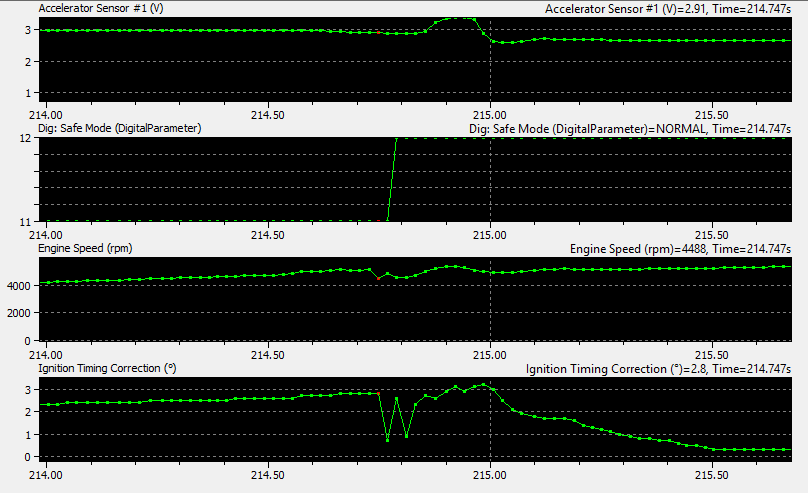
Because it was specifying a code for Crank Position Signal, the trigger disc was the logical culprit. It occurred to us that the disc material might not be thick enough, and the negative space between teeth might not be deep enough. Under high RPM situations, this would cause the signal output (which should essentially look like a square wave) to become messy, and the ECU is, appropriately, responding to the bad signal by trying to protect the engine and entering limp mode.
This is pretty much where we enter Phase 2 of our Manual Swap. We had proven the concept; the car COULD work and drive as a manual, but it wasn’t complete. It wasn’t something you could live with every day, or really reliably use at all. The interior was incomplete, it didn’t have a parking brake, and you couldn’t even hoon it out of fear of the car freaking out and leaving you stranded. So the car took the back-burner for a bit while we collected parts and established a gameplan.
Back to the Grind
Replacing the trigger disc required dropping the transmission. While the transmission was out, we decided to do away with the garbage concentric slave cylinder design Nissan implemented across the board on all “HR” style transmissions, and replace it with a kit we were/are developing. We also continued to trickle in and test fit other interior components from the Euro Q50 in order to complete the interior.
We also had the E-brake to take care of. The factory setup has a foot-brake to the left of the brake pedal. However, the e-brake cable actually enters the interior through the transmission tunnel, just like it would on a manual car. Rather than connecting to a handbrake, it connects to an extension cable that runs behind the dash, behind the pedals, and to the foot brake.
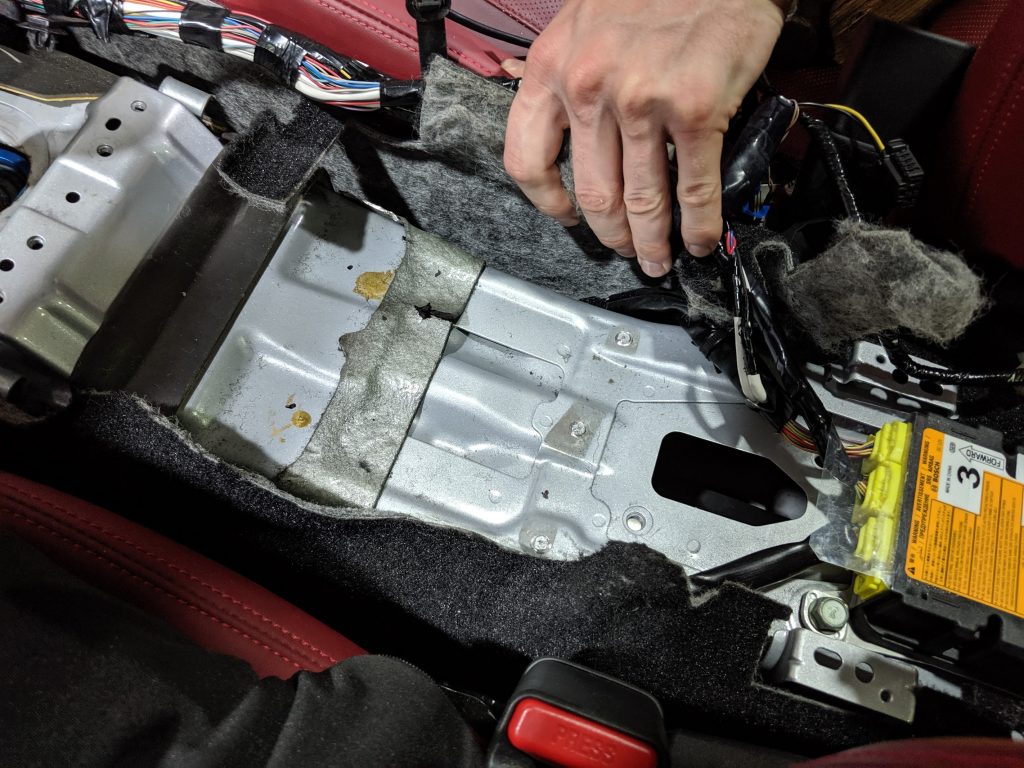
So we simply removed that extension cable, for starters. We also began mocking up a 370Z and Euro Q50 e-brake handle assembly (which frankly weren’t substantially different). The unfortunate reality is the transmission tunnel doesn’t really have provisions for the handbrake at all, other than the area where the cables pass through. But after a lot of test fitting, we drilled some mounting holes, installed riv-nuts, and bolted down the e-brake handle assembly. Josh also designed and 3D-printed a passthrough to allow the cable to come through the transmission tunnel, but isolate road noise and debris.

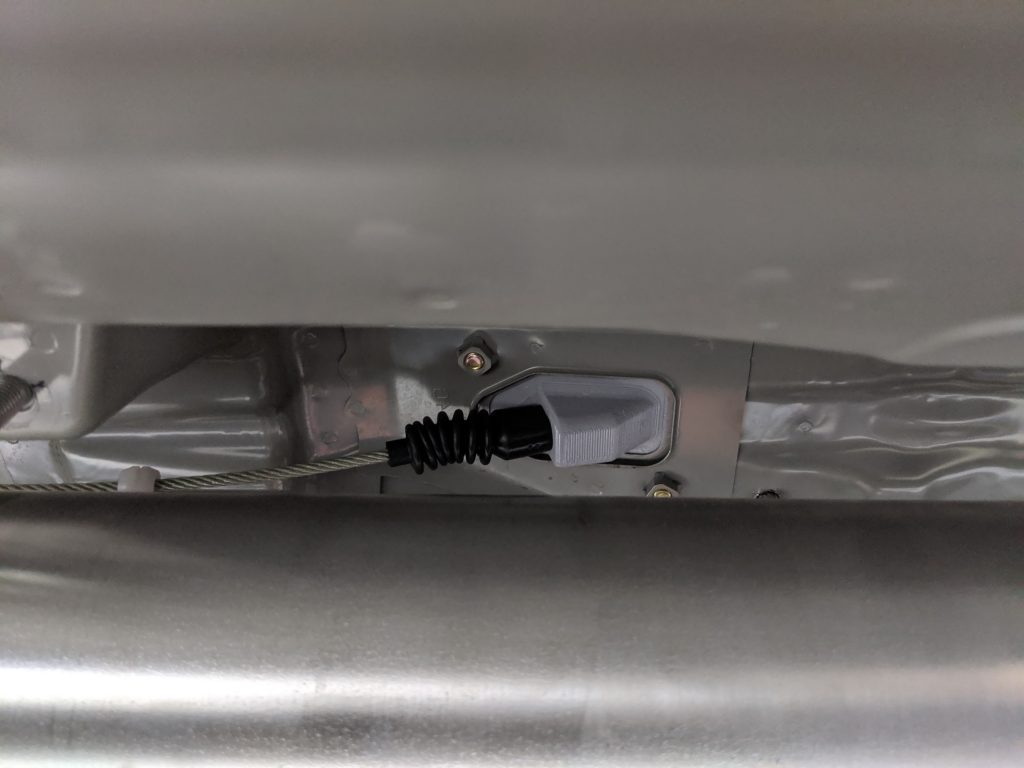
With that done, we had the handbrake assembly successfully installed and functioning, though we still had to fuss with the positioning of the actual center console finisher to make it “right.” The reality is, there just isn’t enough room between the top of the transmission tunnel and the underside of the center console finisher for the e-brake handle. But we’ll get back to that issue later.
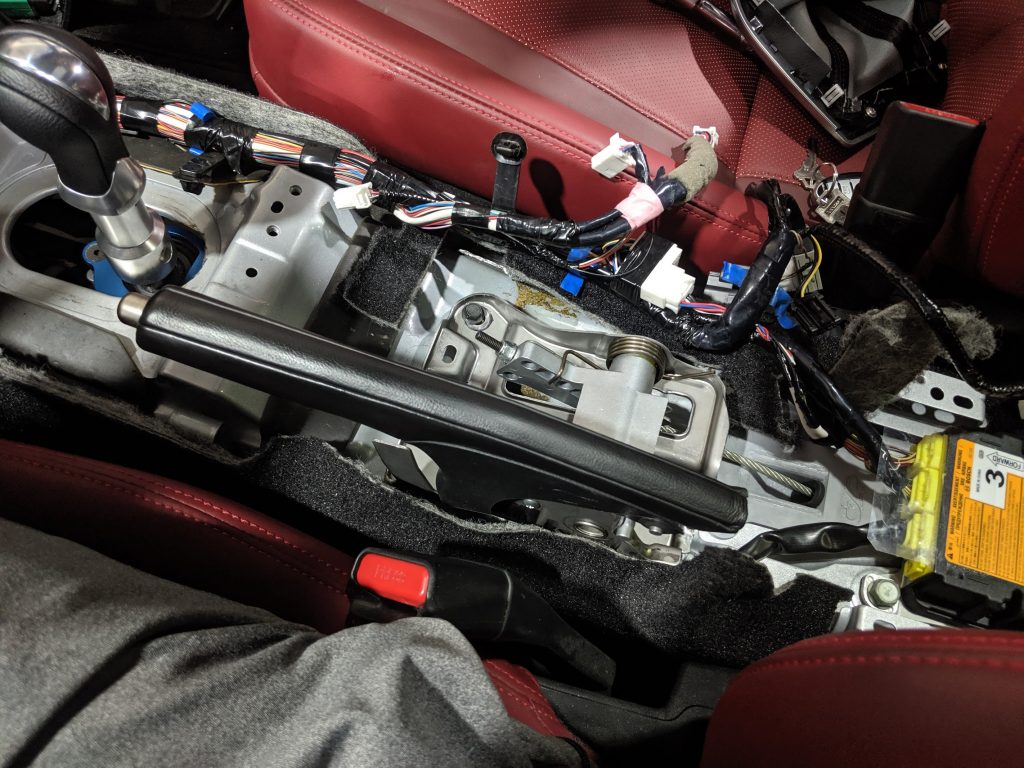
The Final Stretch
Once we got the transmission down, Josh revised his design for the trigger disc and had a new one cut out by a local water jet shop. We also replaced the crank sensor for good measure, and confirmed that the alignment with the sensor was spot on, once we got it back on the flywheel and reinstalled on the engine.
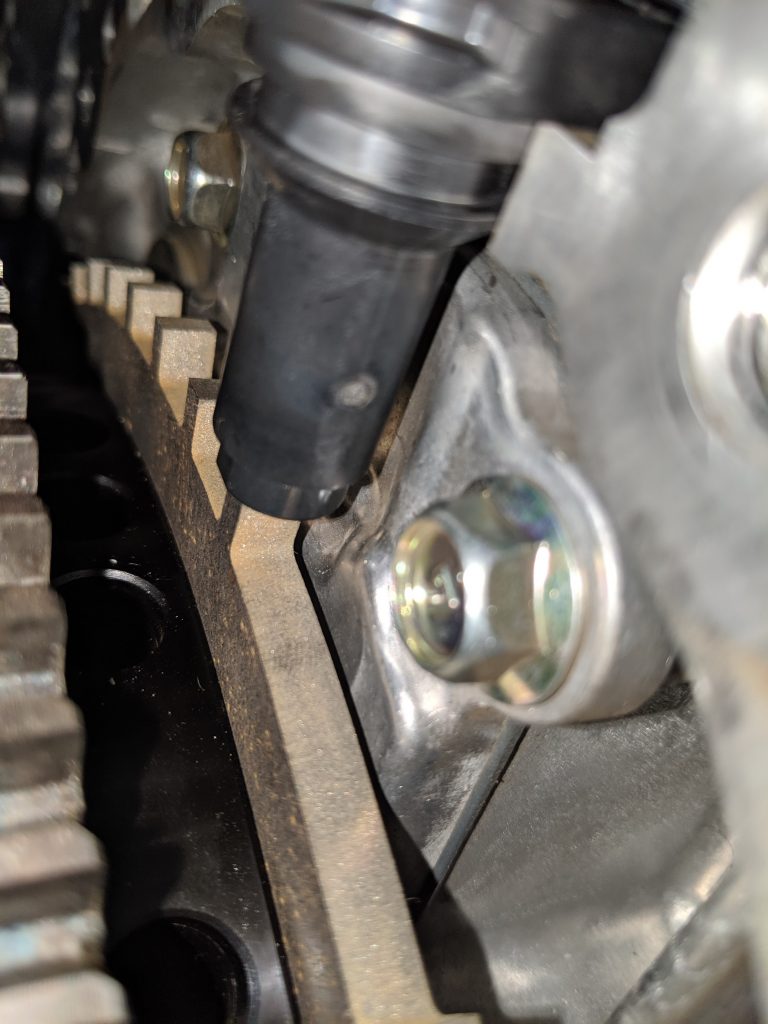
While the transmission was out, we removed the concentric slave cylinder, and Josh began finalizing his work-in-progress CSC delete kit. We haven’t come up with a name for this kit, and haven’t tested it on any other cars yet. But essentially this replaces the crappy plastic CSC with a billet chromoly fork arm and pivot ball, and utilizes the stock 350Z (DE) clutch slave cylinder. It also allows for adjustment at the fork which was especially needed for this setup.
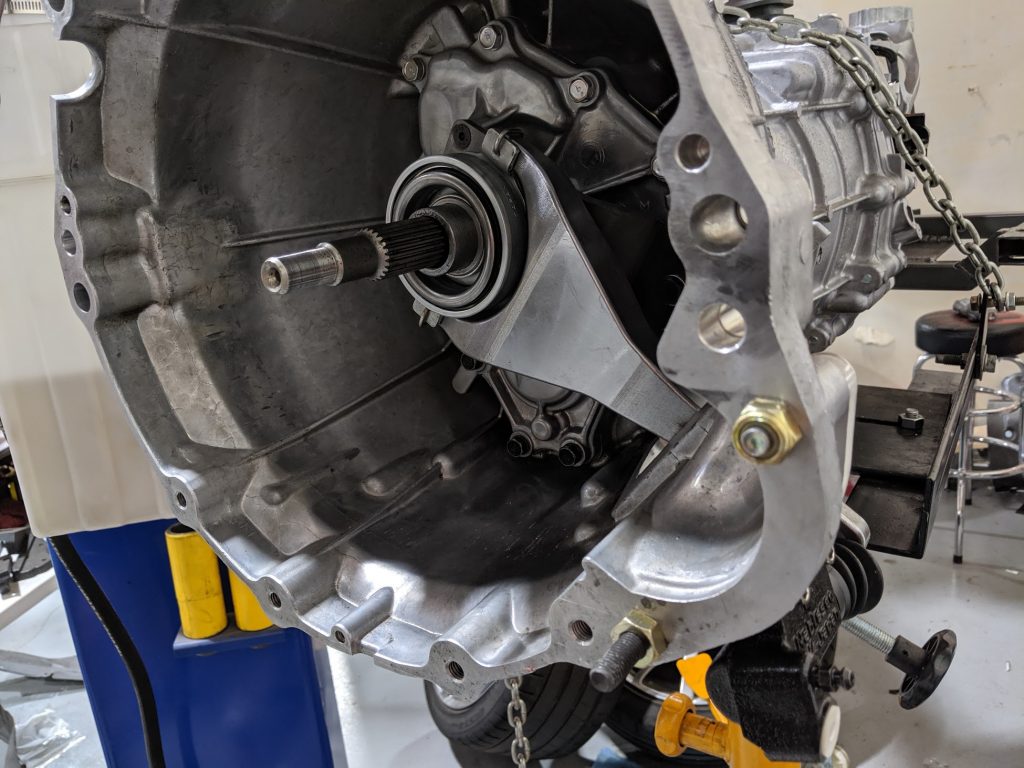
So the transmission went back in. This time with a new release mechanism, with a stock shifter (instead of the short shifter we had), and with a new trigger disc on the flywheel. You can catch part of this process in one of our vlog posts on YouTube:
Josh and I took it for a spin, and we were elated to find that our limp mode issue was resolved! We do believe the updated trigger disc was the culprit. Live and learn! We made some adjustments related to the pedal and fork to improve the feel of the pedal and clutch release/engagement as much as possible.
Finally, we turned our attention to the interior and center console one last time. The only thing missing was the support bracket in the rear of the center console. The Euro Q50 bracket and the Q60 bracket were both incompatible here, so Josh designed a custom one, again printed from durable PETG. It raises the rear end of the center console up a little over an inch, so the e-brake assembly can fit acceptably well, and also gives the center console a stable, strong support.
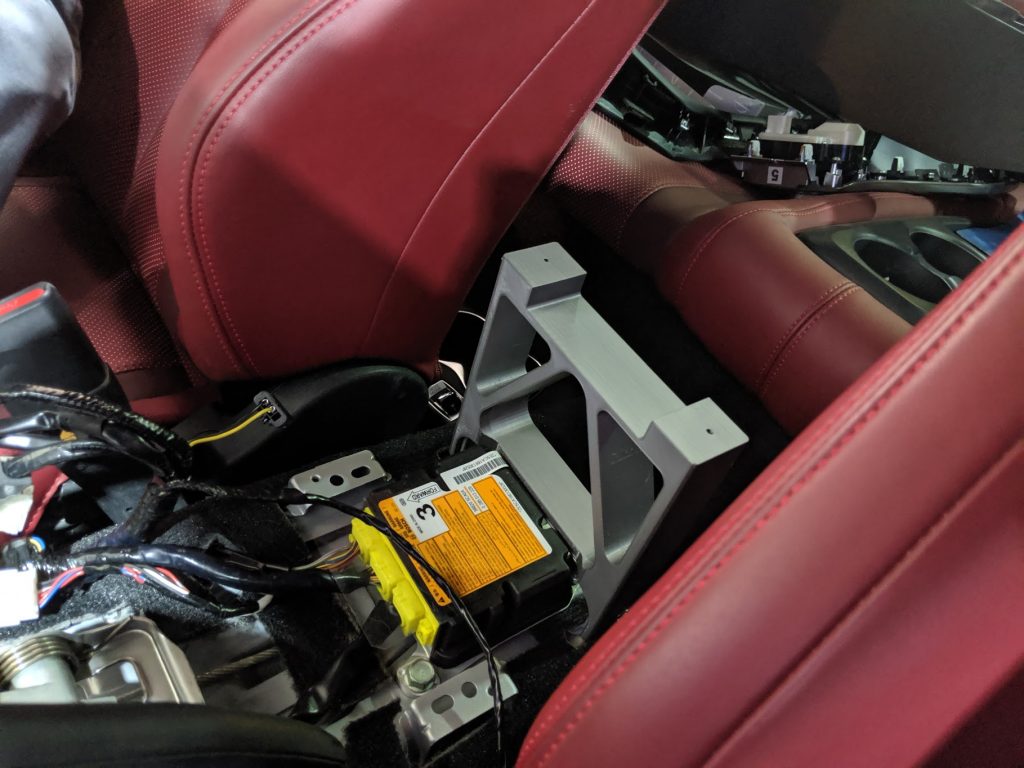
At this point we had already tidied up the harnesses in this area, which involved extending the harness for the Intelligent Key antenna (which is mounted at the very back of the center console now, rather than in the center), binding some unused connectors out of the way, and re-wrapping some branches so they fit under the center console.
We had also finally received ALL of the remaining interior components necessary to complete the center console area, so reassembly went pretty quick and was (mostly) painless.
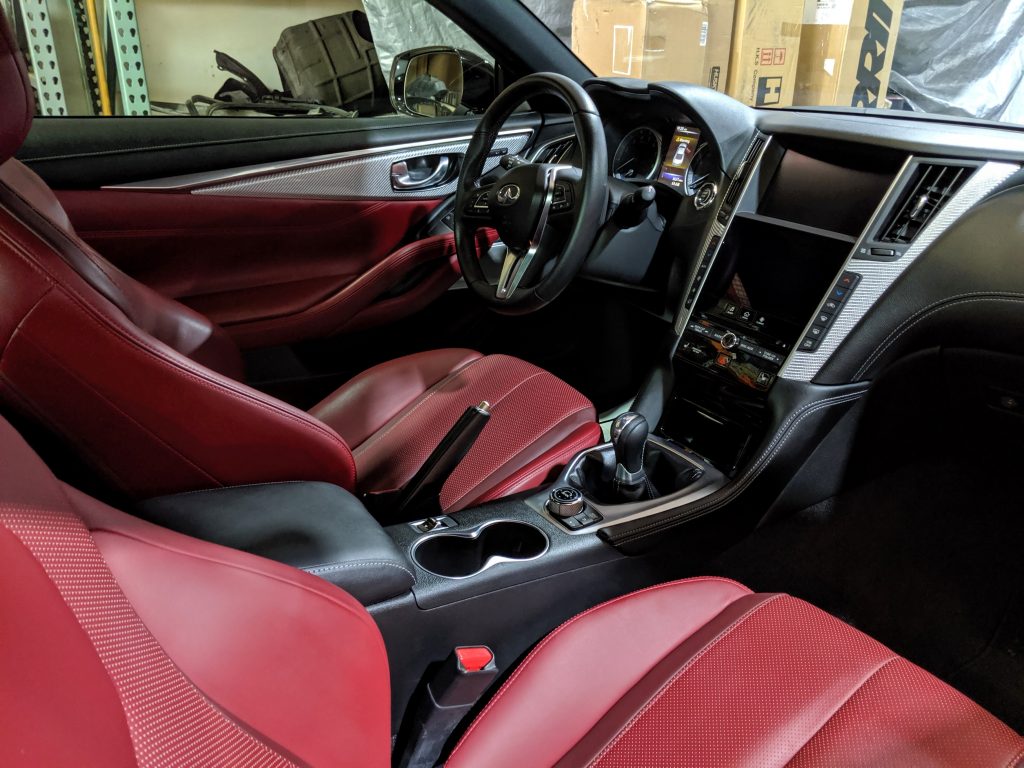
One of our big goals with this whole project has been to make the final product look and feel as close to a factory car as possible. The clutch pedal is very heavy, but we chose a heavy clutch (Southbend SS-TZ, for those wondering) since we needed to support the torque this thing makes. And the car feels… overwhelmingly normal. It feels like a manual car. We’re really proud of the fact that, if not for the exhaust and heavy clutch, you wouldn’t be able to tell it’s not stock.
So finally, this car is done. At least, it’s done for now. It’s a project car and, let’s be honest, are they ever really done? We still have some more immediate upgrades planned for this car, like an LSD, and possibly a custom final drive (despite the Red Sport having the most aggressive final drive, it’s still a pretty low ratio and not ideal for this trans). There are also still some minor quirks; it throws “Key System Error” on the dash even though everything works normally, which also means remote start doesn’t work, but that’s about it. The only other “functions” lost in the swap were the illuminated cup holders, which I’m not going to lose much sleep over.
In the future, we’re planning on performing this conversion on a couple of other cars (including the Q50) and hopefully offering this as a service and/or conversion kit. It’s currently sitting at about $5700 in parts, but we won’t know where it will end up after we’ve done it a few times and revised various aspects and parts.
So that just leaves us with one question: How’d we do?
This….. Is……Amazing!!!!!
This is awesome.
Please do this on a q50 red sport. Wanting to buy one but no manual option has kept me from it.
Hoping to in the near future! The process SHOULD be identical.
I want it for my 18 Q50. How can we make this happen?
if you need another car to test on, I’ll be willing to chat with your team
Bad ass, guys! I’ve wondered about the VRDDTT in a 350z. So much work, you guys are inspirational!
Thank for this. Amazing job! You are all heroes of the highest order.
Very cool! Should have been a manual option from the factory anyways!
Amazing work fellows, I lift my hat to you! I would love to convert my 2016 GMC Sierra 2500HD to 6 speed stick.
Yo this is absolutely insane and I am proud of you guys – makes all of us die hard MT fans so happy to see this kind of stuff!
You all are doing the good Lords work. Save the Manuals
This project is really amazing, very inspirational. If there is going to be an actual product conversion kit or service in the future, I will gladly buy a q60. I’ll trade in my z34 if I have to.
The fact the q50/q60 hasn’t been offered in manual has steered me away. Your kit looks so good that it makes me rethink wanting one
Saying your mods look factory is an understatement. Awesome job!!!
I’ve been really thinking of going Q60 or Subaru BRZ in the near future due to the abilities of both, however, if this manual swap service ever becomes a reliable alternative to the automatic transmission, I’d be all over this car in a heartbeat. Keep up the good work guys!
I’m glad y’all did this. The very thought of automatic (I drive one 11 G37xS) sickens me. Lazy drivers, but never lazy to send a text and crash! Anyway, this forum is old and I would like to get my hands on a Q and do the same. Godspeed CZP (Bigfest poor fan).
Are questions on this blog valid? xD
How wider is the vr30ddtt on bottom and on top compared with a vq35?
I´m thinking about doing a vr30 swap in another platfform
I don’t have exact dimensions, but they are very similar in terms of height and width. The intercoolers and turbos make everything slightly wider, but not by much.
This is great work! I hope this would be an option later on.
Please try the hydraulic steering swap too guys! you guys are awsome.
Please tell me the ATTESA AWD system will also work with this swap (as it attaches at the the back end of the tranny) if I could get a RS400, q50 or 60, with AWD and a manual gearbox, I… I don’t know… my head would explode!
Will You Guys Ever Make/Fabricate a COMPLETE Swap Kit For Us Fans To Purchase?
It’s definitely possible and really the goal we’re working to!
Holy guacamole balls. Insanely amazing!!
Amazing. I am interested in upgrading my g37 to a newer Infiniti but I am sad there is no manual model available … I think they need to offer the option going forward! This is great work ! We should all urge Infiniti to bring back the stick shift though, everyone reading this needs to reach out and ask corporate there! It is still in demand! Especially for those seeking sports coupes.
Any updates if the conversion kit is available?
Same as Kyle wb, are you guys offering this swap yo customers or selling a kit? I have a g37 but wanted the new Q60 badly but haven’t bought it due is automatic, can any respond back?
You guys are moving the needle! Seriously, Nissan followed your lead by putting a manual transmission on the new Z! Keep it up boys!
Oh man, that is AWESOME!
Take my money

I would like to know the cost for everything if I drop off a q60. I love this car
Totally freaking awesome! You transformed the Q60 RedSport into a car actually worth owning! Not just worth owning, but hey, what an awesome car this now is! An honest-to-god manual transmission in the twin-turbo 400t (or whatever they call this engine). And you know, now that the Nissan Z with the same engine and a manual transmission is imminent, this transformation should be way, way easier than what you had to go through. As soon as someone totals a new 2023 Z, you guys should buy the totaled car to use all the transmission (and handbrake) stuff to do this again. And you’ll have an extra engine and a bunch of other spare components for other swaps. Just think of all the problems that you had to solve that will now be soooo much simpler.
Since the new Z shares the same engine, you think the manual transmission would be a perfect fit on the Q60?? What about the electric components such the ECU? If the new Z is the manual version of the Q60 that would make things way easier
The transmission on the new Z would definitely be a direct fit. It’s basically a 370Z transmission with a modified bellhousing to fit the VR30, upgraded synchros on 1st and 2nd, and it switches to an external slave cylinder (thankfully).
But honestly, the transmission is a pretty minor barrier with this swap. The ECU/wiring is the hard stuff, and I’d pretty much guarantee the Z ECU won’t be compatible with the Q60. There are just too many differences with the body/interior/gauge cluster stuff. It MIGHT be enough to get it to start and drive, but I would bank on it throwing even more errors than the Q60 ECU.
I’ve driven manuals all my life. My last manual was a G37 6MT 4 door, then traded in on an M37 sport. Now, I have a ‘18 Q50 Red Sport, but my left foot still looks for a clutch pedal every so often. I NEED this swap!
Phenomenal job guys! Enjoyed the build, and even got in a few laughs. Thanks for the dedication and in keeping the passion alive for custom and performance vehicles, while supporting the Nissan/Infiniti brand & legacy.
You guys have done the hard part by designing the conversion and figuring out the details. Get them up on your site so I can finally give in and put a down payment on a Q60! Automatic as the only option is the single reason I don’t own one.
I’ve always wanted a Q60 Red Sport because I love how aggressively luxurious it looks, but could never justify buying one because of the flappy paddles and weaker drivetrain. Especially since I’ve always planned on making more power. You guys are absolute saviors for for the time, effort, and expertise you’ve all put into this creation!!! I hope the LSD becomes a viable option and you all get the car dialed in to your satisfaction for customers. I am officially saving my money now because I want one as soon as possible! #savethemanuals
Is there a resource for gettimg copys of stock roms like 6HJ6B?
I swapped a VR30 into my 350z and I am looking for a means of nats delete and manual switch.
Hey Andrew, if you have an EcuTek tuner, they can update your ROM for you